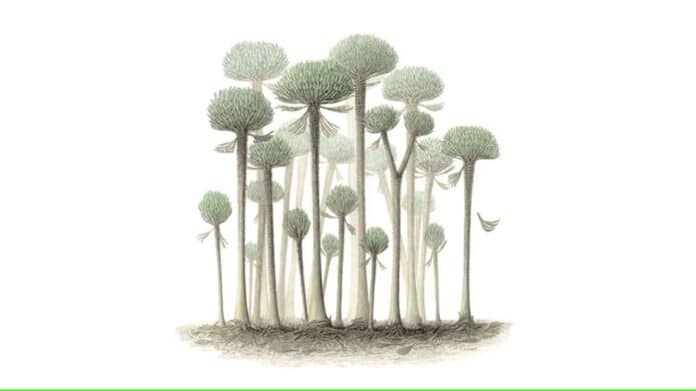The development of forests and trees significantly impacted Earth’s land ecosystem during the Devonian Period. Through the stabilization of silt and its interaction with flowing air and water, this metamorphosis also impacted geomorphology and physical habitats. Plants with woody tissue, or lignophytes, began to influence the landscape during the mid-Givetian Age and continued to do so. However, more is needed to know about the effects of past forests, which were dominated by less woody species like cladoxylopsids.
In a new study, scientists report about a previously unrecognized cladoxylopsid forest landscape archived within the Eifelian Hangman Sandstone Formation of Somerset and Devon, SW England. This is the oldest fossilized forest known on Earth – dating from 390 million years ago.
Researchers from the Universities of Cardiff and Cambridge have located and identified the earliest petrified trees ever unearthed in Britain. These fossils outdate the previous record holder discovered in New York State and constitute the oldest known fossil forest on Earth.
These petrified trees, belonging to the Calamophyton species, are situated near Minehead on the south bank of the Bristol Channel, near a Butlin’s vacation cabin. Though they appear to be palm trees at first glance, they were the prototype for modern trees. Their branches were covered in hundreds of twig-like formations, and their thin, hollow trunks were devoid of leaves.
The tallest ancient trees found close to Minehead measured only two to four meters in height, making them shorter than contemporary trees. As they matured, these trees produced a lot of vegetative litter on the forest floor, supporting a variety of insects.
This fossil discovery calls into question previous theories regarding the absence of noteworthy plant fossils along the English coast. Furthermore, it clarifies how, hundreds of millions of years ago, early trees were essential in forming landscapes and supporting riverbanks and coastlines.
Professor Neil Davies from Cambridge’s Department of Earth Sciences, the study’s first author, said, “The Devonian period fundamentally changed life on Earth. It also changed how water and land interacted since trees and other plants helped stabilize sediment through their root systems, but little is known about the earliest forests.”
Co-author Dr Christopher Berry from Cardiff’s School of Earth and Environmental Sciences said, “When I first saw pictures of the tree trunks, I immediately knew what they were, based on 30 years of studying this type of tree worldwide.”
“It was amazing to see them so close to home. But the most revealing insight comes from seeing, for the first time, these trees in the positions where they grew. It is our first opportunity to look directly at the ecology of this earliest type of forest, to interpret the environment in which Calamophyton trees were growing, and to evaluate their impact on the sedimentary system.”
Journal Reference:
- Neil S. Davies, William J. McMahon et al. Earth’s earliest forest: fossilized trees and vegetation-induced sedimentary structures from the Middle Devonian (Eifelian) Hangman Sandstone Formation, Somerset and Devon, SW England. Journal of the Geological Society. DOI: 10.1144/jgs2023-204
